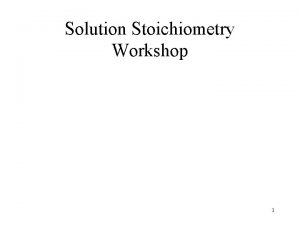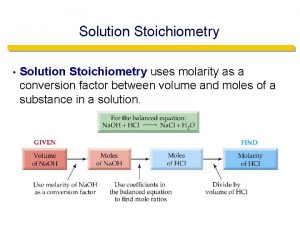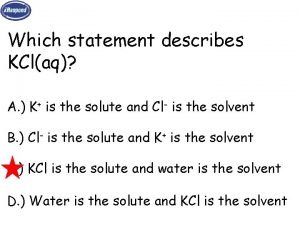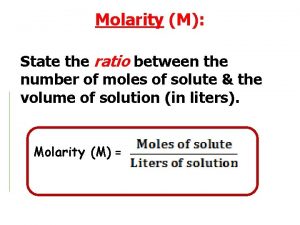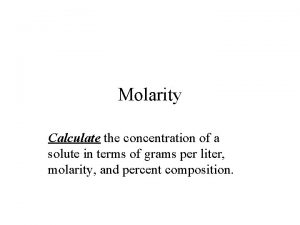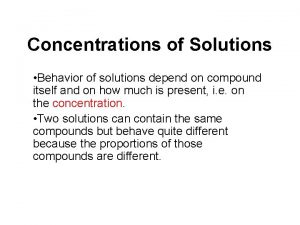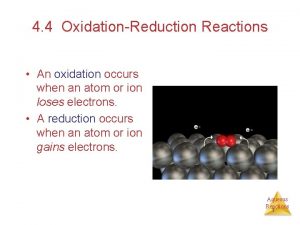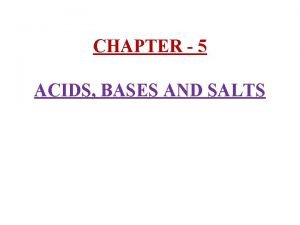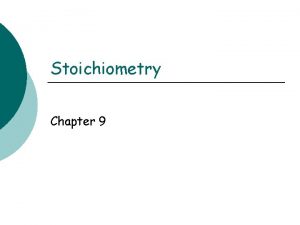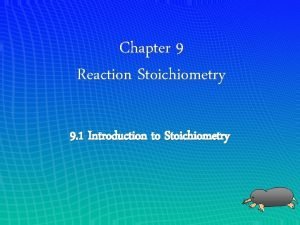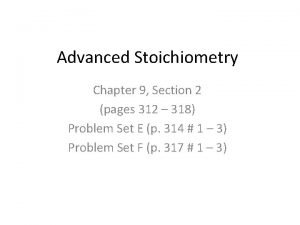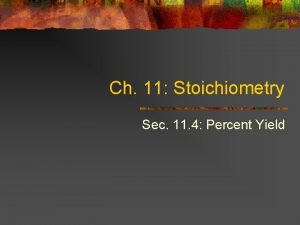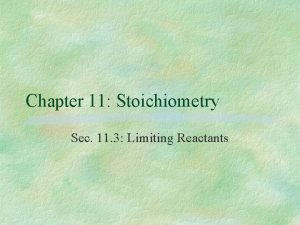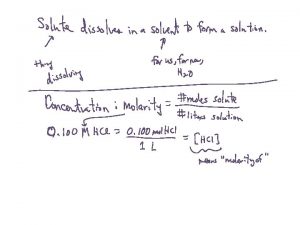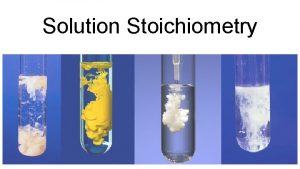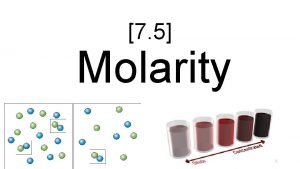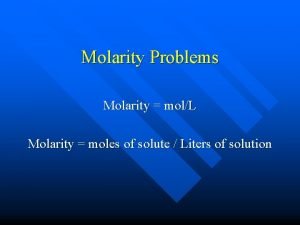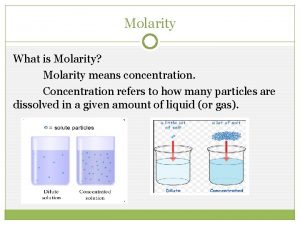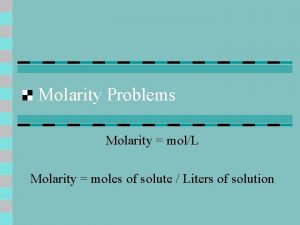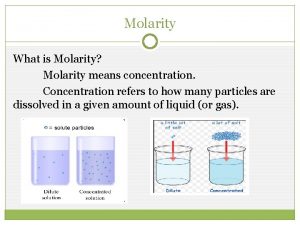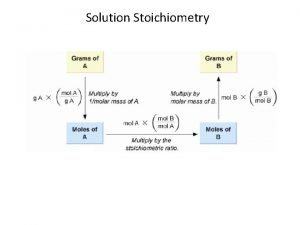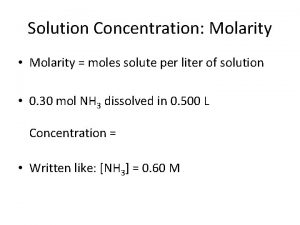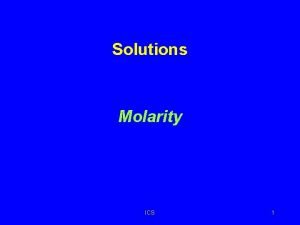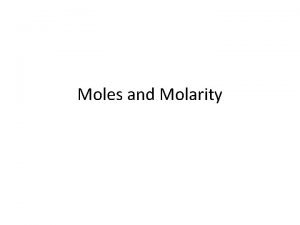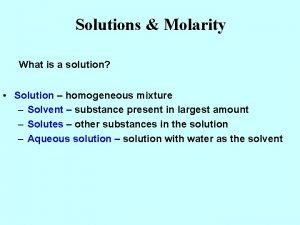Solutions Part II Molarity Solution Stoichiometry Chapter 4































- Slides: 31

Solutions Part II: Molarity & Solution Stoichiometry Chapter 4 Sec 7 -9 of Jespersen 7 TH Ed Dr. C. Yau Spring 2015 11

Molarity (M) is a unit of concentration. Know this well! Always remember that…M is a fraction in disguise. Note that it's "L of solution" not "L of water!" When you see 3. 00 M HCl you should immediately be thinking… 22

Molarity vs. Molar Mass This concept and use of molarity is as important as that of molar mass. You learned molar mass gives you. . . Now you must learn molarity gives you. . . Learn it NOW!. . . the sooner the better! 3

Molarity is NOT a quantity. 3 M HCl means there are 3 moles of HCl per liter of solution. It does NOT mean you have 3 moles, nor does it mean you have one liter. It’s like going to the store to buy apples and the price is $2 per pound. It doesn’t mean you have to pay $2, nor does it mean you have to buy one pound. 44

Molarity There are 2 important things you should remember about molarity. 1) As a fraction, it is a conversion unit between… moles solute L soln If you know how many moles of solute, you can calculate the volume. If you know the volume, you can calculate the number of moles of solute. 55

Molarity 2) The equation can be rearranged to a very useful format: # moles = Molarity x Volume (in L) KNOW THIS WELL!! You will often need to know the # moles of the solute in a solution. REMEMBER … # moles = M x V Sometimes written as n=Mx. V 6 6

Example 4. 10 p. 185 To study the effect of dissolved salt on the rusting of an iron sample, a student prepared a solution of Na. Cl by dissolving 1. 461 g of Na. Cl in a total volume of 250. 0 m. L. What is the molarity of this solution? Example 4. 11 p. 186 How many milliliters of 0. 250 M Na. Cl solution must be measured to obtain 0. 100 mol of Na. Cl? Do Pract Exer 26 & 27 p. 187 77

Example 4. 12 p. 188 Strontium nitrate is used in fireworks to produce brilliant red colors. Suppose we need to prepare 250. 0 m. L of 0. 100 M Sr(NO 3)2 solution. How many grams of strontium nitrate are required? Tips: 1) You see V and you see M and immediately you should be thinking Mx. V = # moles. 2) You have moles and question is asking about grams, what do we need? Practice Exercises #28, 29, 30 on p. 189 88

Preparing a Solution of a Specified Molarity Be sure you can describe exactly how you would prepare a solution of a specified molarity (such as in Example 5. 12). Answer was 5. 29 g strontium nitrate to prepare the 250. 0 m. L of 0. 100 M soln. Because molarity is based of L of solution and not L of water, you cannot just add 250. 0 m. L of water to 5. 29 g Sr(NO 3)2 It requires a special apparatus called the "volumetric flask. " 99

The volumetric flask, unlike the graduated cylinder, has only one graduation mark. The one shown on the right is for 250 m. L. It has one mark on the neck. When it is filled with a liquid up to that mark, it contains 250. 00 m. L of the liquid. 10 10

Volumetric Flasks They come in standard sizes: 5 m. L, 10 m. L, 25 m. L, 50 m. L, 100 m. L 250 m. L, 500 m. L, 1 L, 2 L etc. We don’t have ones like 30 m. L or 75 m. L, etc. 11

Describe exactly how you would prepare 250 m. L of 0. 100 M Sr(NO 3)2. You should know that Sr(NO 3)2 is an ionic compound and therefore it is a solid to begin with. We would need to weigh out a certain amount of the solid. First you would calculate how much you need to weigh out. Previously the answer we obtained was 5. 29 g. Ans. I would weigh out 5. 29 g of Sr(NO 3)2, transfer it quantitatively into a 250 -m. L volumetric flask, dilute to the mark with distilled water and shake it to mix thoroughly. 12 12

Preparation of a Solution by Dilution of a More Concentrated Solution. Example 4. 13 p. 189 How can we prepare 100. 0 m. L of 0. 0400 M K 2 Cr 2 O 7 from 0. 200 M K 2 Cr 2 O 7? Tips: There is no mention of grams, so do not try to use molar mass! You should first recognize this is a "dilution problem. " A "dilution problem" utilizes a special equation. 13 13

EQUATION FOR DILUTION PROBLEMS Recognize that we are talking about 2 solutions: one dilute and one concentrated. Mdil x Vdil = Mconc x Vconc We often just write… M 1 V 1 = M 2 V 1 and V 2 can be any unit of volume as long as they are the same units. 14 14

Example 4. 13 p. 189 How can we prepare 100. 0 m. L of 0. 0400 M K 2 Cr 2 O 7 from 0. 200 M K 2 Cr 2 O 7? Instead of Mdil Vdil we can just assign one solution with M 1 V 1. M 1 = 0. 0400 M M 2 = 0. 200 M V 1 = 100. 0 m. L V 2 = ? m. L M 1 V 1 = M 2 V 2 First we solve for V 2, to get… so Do Pract Exer 31 & 32 p. 190 15 15

Prep of 100. 0 m. L of 0. 0400 M K 2 Cr 2 O 7 from 0. 200 M K 2 Cr 2 O 7 Fig. 5. 25 (b) (c) (d) p. 191 (a) Measure 20. 0 m. L of 0. 200 M K 2 Cr 2 O 7 w/ pipet. (b) Transfer to 100 -m. L volumetric flask. (c) Dilute to the mark with distilled water. (d) After mixing, we have 100. 0 m. L of 0. 0400 M. 16

Example: (not from book) What is the molar concentration of sodium ions in 0. 500 M sodium sulfate? What is the molar concentration of IO 3 - in 0. 240 M KIO 3? 17

Example: (not from book) 3. 0 L of 2. 0 M Na. Cl is mixed with 4. 0 L of 4. 0 M Ca. Cl 2. What is the molar concentration of chloride ions in the resulting solution? HINT: What units would the answer have? 18

NOTE OF CAUTION The equation of M 1 V 1 = M 2 V 2 can be used ONLY for dilution problems. The relationship of # mol = # mol works only because the # mol does not change in the two solutions. The # mol of solute transferred from the concentrated solution must equal to the # mol of solute that ends up in the dilute solution. This is true only because no rxn is involved! 19 19

Solution Stoichiometry You have had stoichiometry problems and were working with grams and molar mass. In "solution stoichiometry" we often just use molarity instead of molar mass. How do you know whether you need molar mass? If the problem only involves only volume and does not mention mass, you would not need it. "Stoichiometry" still means you need the coefficients of the balanced equation. 20 20

Example 4. 14 p. 191 One of the solids present in photographic film is silver bromide, Ag. Br. Suppose we wish to prepare Ag. Br by the following precipitation reaction. 2 Ag. NO 3 + Ca. Br 2 2 Ag. Br + Ca(NO 3)2 How many milliliters of 0. 125 M Ca. Br 2 solution must be used to react with the solute in 50. 0 m. L of 0. 115 M Ag. NO 3. Tips: Remember M x V = # moles ! Do Pract Exer 33 & 34 p. 192 21 21

2 Ag. NO 3 + Ca. Br 2 (aq) 2 Ag. Br + Ca(NO 3)2 (s) (aq) 23. 0 m. L of 0. 125 M Ca. Br 2 soln must be added to react with 50. 0 m. L of 0. 115 M Ag. NO 3 to form solid Ag. Br. 22

Example 4. 15 p. 193 What are the molar concentration of the ions in 0. 20 M aluminum sulfate? Example 4. 16 p. 194 A student found that the sulfate ion concentration in a solution of Al 2(SO 4)3 was 0. 90 M. What was the concentration of Al 2(SO 4)3 in the solution? Pract Exer 35 & 36 p. 194 23 23

Example 4. 17 p. 194 How many milliliters of 0. 100 M Ag+ solution are needed to react completely with 25. 0 m. L of 0. 400 M Ca. Br 2 solution? The net ionic equation for the reaction is Ag+ (aq) + Br- (aq) Ag. Br (s) Do Pract Exer 37 & 38 p. 195 24

Example 4. 18 p. 196 A chemist was asked to analyze a soln of chlordane, C 10 H 6 Cl 8, dissolved in a hydrocarbon solvent that was discovered by construction workers during demolition of an old work shed. This insecticide was banned for sale in the US in 1988 by the EPA b/c of its potential for causing cancer. 25

Example 4. 18 p. 196 (cont’d. ) Rxns were carried out on a 1. 446 g sample of the soln which converted all of the chlorine to chloride ion dissolved in water. This aq soln required 91. 22 m. L of 0. 1400 M Ag. NO 3 to precipitate all of the chloride ion as Ag. Cl. What was the percentage of chlordane in the original soln? The ppt’n rxn was. . . Ag+ (aq) + Cl- (aq) Ag. Cl (s) Chlordane = C 10 H 6 Cl 8 Do Pract Exer 39 & 40 p. 197 26

Titration "Titration" is a lab procedure to determine the amount of substance present in a sample (usually in percent or molar concentration) by volumetric analysis. The apparatus used include a buret and sometimes a pipet to measure out volume. The "equivalence point" is the instant a stoichiometric amount of solution has been delivered from the buret. (The molar ratio shown by the coefficients of the balanced equation has been reached. ) The term "titrant" refers to the carefully measured volume delivered from a buret at the equivalence point. The "end point" is a point close to the equivalence point that is made visible by the use of an indicator that changes color at or near the equivalence point. 27

The 50 -m. L Buret: 0. 00 The graduation goes from 0. 00 m. L at the top down to 50. 00 m. L at m. L the bottom. An initial buret reading is recorded, and after the endpoint, the final buret reading is recorded. 50. 00 The difference between the two m. L (final reading – initial reading) gives the volume of solution that has been delivered through the stopcock at the bottom. This volume of solution is known as the titrant. 28

The Volumetric Pipet, also known as the Transfer Pipet Similar to the volumetric flask, there is only one graduation mark on the narrow top section of the pipet. Pipets come in standard sizes, such as 1. 00 m. L, 5. 00 m. L, 10. 00 m. L, 25. 00 m. L, 50. 00 m. L. They seldom go to larger volumes because the solution would be too heavy to draw up into the pipet. The liquid is drawn up into the barrel with the use of a bulb (or pipet pump) up to the calibration mark and then allowed to drain into the desired container. 29

Example 4. 19 p. 198 A student prepares a soln of hydrochloric acid that is approximately 0. 1 M and wishes to determine its precise concentration. A 25. 00 m. L portion of the HCl soln is transferred to a flask, and after a few drops of indicator are added, the HCl solution is titrated with 0. 0775 M Na. OH solution. The titration requires exactly 37. 46 m. L of the standard Na. OH solution to reach the end point. What is the molarity of the HCl solution? Do Pract Exer 41 & 42 p. 199 30

Solving Multi-Concept Problems (p. 200) Milk of magnesia is a suspension of Mg(OH)2 in water. It can be made by adding a base to a soln containing Mg 2+. Suppose that 40. 0 m. L of 0. 200 M Na. OH soln is added to 25. 0 m. L of 0. 300 M Mg. Cl 2 soln. What mass of Mg(OH)2 will be formed, and what will be the concentrations of the ions in the soln after the rxn is complete? What is the strategy? What is the first step in solving this problem? 31
 Calculate molarity of solution
Calculate molarity of solution Molarity and stoichiometry
Molarity and stoichiometry Molarity stoichiometry
Molarity stoichiometry Molarity and stoichiometry
Molarity and stoichiometry Which phrase describes the molarity of a solution?
Which phrase describes the molarity of a solution? Molarity equation examples
Molarity equation examples How to calculate molarity
How to calculate molarity Molarity
Molarity Aqueous reactions and solution stoichiometry
Aqueous reactions and solution stoichiometry Types of chemical reactions and solution stoichiometry
Types of chemical reactions and solution stoichiometry Types of chemical reactions and solution stoichiometry
Types of chemical reactions and solution stoichiometry Solution stoichiometry
Solution stoichiometry Solution stoichiometry
Solution stoichiometry Solution stoichiometry
Solution stoichiometry Chapter 11 stoichiometry test
Chapter 11 stoichiometry test Vapour pressure
Vapour pressure 5 taste
5 taste Chemistry chapter 9 stoichiometry
Chemistry chapter 9 stoichiometry Chapter 9 section 3 stoichiometry
Chapter 9 section 3 stoichiometry Chapter 11 stoichiometry
Chapter 11 stoichiometry Chapter 9 review stoichiometry
Chapter 9 review stoichiometry Chapter 9 stoichiometry
Chapter 9 stoichiometry The first step in most stoichiometry problems is to ____
The first step in most stoichiometry problems is to ____ Chapter 9 review stoichiometry section 2
Chapter 9 review stoichiometry section 2 Chapter 12 stoichiometry answer key pearson
Chapter 12 stoichiometry answer key pearson Stoichiometry ratio
Stoichiometry ratio Chapter 3 stoichiometry answer key
Chapter 3 stoichiometry answer key Chapter 12 stoichiometry
Chapter 12 stoichiometry Define percent yield
Define percent yield 11-3 practice problems
11-3 practice problems D'leon inc part 1 solution
D'leon inc part 1 solution Part whole model subtraction
Part whole model subtraction

